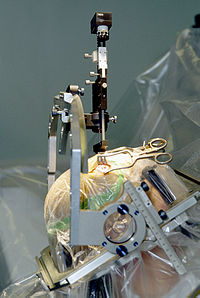
Photo from wikipedia
Objective: Our purpose is to define the learning curve for robot-assisted thoracoscopic surgery lobectomy by reporting the experience of a single surgeon. Material and methods: We progressively collected the data… Click to show full abstract
Objective: Our purpose is to define the learning curve for robot-assisted thoracoscopic surgery lobectomy by reporting the experience of a single surgeon. Material and methods: We progressively collected the data concerning the surgical performance of a single male thoracic surgeon, from the beginning of his robotic activity as first operator from January 2021 to June 2022. We evaluated several pre-, intra- and postoperative parameters concerning patients and intraoperative cardiovascular and respiratory outcomes of the surgeon, recorded during surgical interventions, in order to evaluate his cardiovascular stress. We used cumulative sum control charts (CUSUM) to analyze the learning curve. Results: A total of 72 lung lobectomies were performed by a single surgeon in this period. Analyzing the CUSUM of several parameters, the inflection point identifying the transition beyond the surgeon learning phase was reached at cases 28, 22, 27 and 33 when considering operating time, mean heart rate, max heart rate and mean respiratory rate, respectively. Conclusions: The learning curve for robotic lobectomy seems to be safe and feasible with a correct robotic training program. The analysis of a single surgeon from the beginning of his robotic activity demonstrates that confidence, competence, dexterity and security are achieved after about 20–30 procedures, without compromising efficiency and oncological radicality.
Journal Title: Journal of Personalized Medicine
Year Published: 2023
Link to full text (if available)
Share on Social Media: Sign Up to like & get
recommendations!